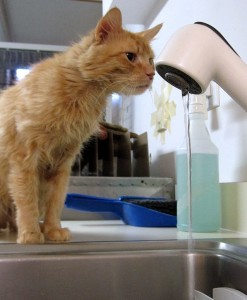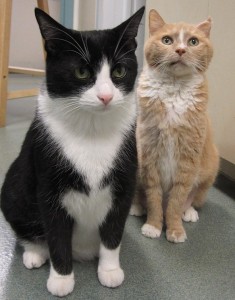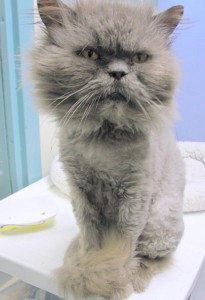We hear from readers looking for help with CRF issues all the time. This is part one of a three part series from The Cat Doctor on the diagnosis and treatment of this all too common condition in cats.
by Lori Horwedel, client educator at The Cat Doctor, Philadelphia, PA.
Because of the large amount of information out there about kidney disease, we are dividing this post into a few installments. This week, we’re discussing what Chronic Renal Failure is, what the symptoms are, and how it is diagnosed. We will discuss treatment and progression in further blog posts.
Chronic renal failure, or kidney disease, is one of the most common diseases affecting older cats. In most cases, renal disease progresses slowly over time, resulting in a gradual onset of symptoms over months or even years. Regular exams and labwork can help diagnose renal disease in the early stages.

What do the kidneys do?
The kidneys have several important functions: They act as filters, ridding the body of toxins (primarily urea and creatinine) and maintaining electrolyte balance. They produce erythropoietin, which helps the body create red blood cells, and renin, which regulates blood pressure. Lastly, the kidneys produce and concentrate urine, which flushes the filtered toxins out of the body. When a cat’s kidney function is compromised, waste products build up in the bloodstream, potassium, calcium, phosphorus and sodium levels become imbalanced, and the ability to produce red blood cells and regulate blood pressure is affected. Compromised kidneys will have to work harder to rid the body of toxins, producing more urine and causing dehydration when the cat cannot drink enough water to make up for the amount she is losing.

What are the signs of CRF?
A cat with renal disease might exhibit any of the following symptoms:
- increased drinking and urination
- weight loss
- vomiting (food or clear liquid/foam)
- nausea/lip smacking
- drooling
- loss of appetite
- muscle wasting
- constipation
- decreased grooming/poor hair coat
- bad breath
- weakness
- dehydration
- hovering over water dish
Chronic renal failure is typically a disease of older cats, though genetics, diet, and other disease processes can play a role in declining kidney function. In many cases, the kidneys simply “wear out” when the nephrons that eliminate waste products and keep electrolytes in balance begin to die off, decreasing the kidneys’ ability to filter out toxins. CRF can also be the result of genetic issues such as Polycystic Kidney Disease, which is most common in Persian-type cats. With PKD, cysts develop in the kidneys and normal function is lost. Cats can also be born with abnormalities to one or both kidneys, or with only one kidney. In these cases, the functioning kidney is under more stress than it would be in a cat with two normal kidneys.
Dental disease can contribute to CRF if left untreated; bacteria from the oral cavity get into the bloodstream and force the kidneys to work harder. It is important to your cat’s kidney health to address dental heath issues as they occur. High blood pressure can be a product of kidney disease, but it can also cause damage to the kidneys by increasing their workload. Urinary tract infections, if left untreated, can lead to kidney disease and kidney infections, and stones can cause both chronic and acute kidney disease. Regular health screening can catch theses issues before they cause too much damage.
Acute Renal Failure
Chronic renal failure is a progressive deterioration of the kidneys, but cats can also experience acute renal failure when their kidneys abruptly cease functioning. This can be caused by urinary obstructions, infection, trauma, and the ingestion of toxins. Cats in acute renal failure experience an abrupt shutdown of kidney function and need immediate medical intervention if they are to survive.
How is CRF diagnosed?
There are several conditions with symptoms similar to those seen in cats with CRF. The only way to know for sure is to have your veterinarian run laboratory tests checking your cat’s blood chemistries and ability to concentrate urine. It is also recommended to screen for high blood pressure, especially in geriatric cats and those who are suspect for kidney disease.
___
The Cat Doctor is a full service medical and surgical facility exclusively for cats. Established in 1983, in the Art Museum area of Philadelphia, the hospital has served the Philadelphia community well for over twenty years, providing excellent comprehensive and compassionate care.
The Cat Doctor works with local rescues and animal welfare organizations, and is well known to readers who followed the case of Clark Kent. In cooperation with rescue group City Kitties, The Cat Doctor cared for Clark after he was found, cold, wet, abandoned and near death, and provided photos and updates for his thousands of supporters and well-wishers.
The practice also maintains an active Facebook page, where visiting cats and staff mascot and blood donor kitty Diamond get their pictures and updates posted regularly.
This article is reprinted with permission from their website, where it is posted here.
